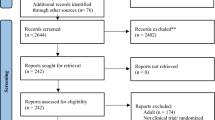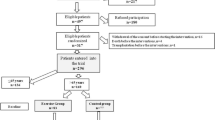Abstract
In contrast to the adult population, little is known regarding health-related quality of life and exercise tolerance in children with end-stage renal disease (ESRD) undergoing chronic intermittent hemodialysis. We designed a pilot study to investigate whether research into this area is indicated. The aim of this study was to describe the motor skills, exercise tolerance, and health-related quality of life in children with ESRD. The study population consisted of ten hemodialysis patients (aged 7–16 years). In eight children motor proficiency according to Bruininks-Oseretsky was determined. In all ten children a progressive exercise test on a treadmill was performed. The results were compared with an age-matched healthy reference group. Nine children filled in the TNO-AZL Child Quality of Life (TACQOL) scoring list. One child had a markedly reduced fine motor skills capacity; another five children scored ≤−2 SD compared with healthy children in gross motor skills. Seven children showed a diminished VO2max (per kilogram body weight); six of these are physically inactive. Four of these seven children did not sustain the maximum workload. The self-assessed physical and mental health of children on dialysis seems comparable to the general population. We found no correlation between exercise performance or motor skills and hemoglobin levels, Kt/V, and time on dialysis. In conclusion, in this study most children had a reduced exercise tolerance and gross motor skills. There was no difference in fine motor skills. Pediatric dialysis patients report a good health-related quality of life.
Similar content being viewed by others
References
Brodin E, Ljungman S, Hedberg M, Sunnerhagen KS (2001) Physical activity, muscle performance and quality of life in patients treated with chronic peritoneal dialysis. Scand J Urol Nephrol 35:71–78
Johansen KL, Chertow GM, Mulligen K, Carey S, Schoenfeld PY, Kent-Braun JA (2000) Physical activity levels in patients on hemodialysis and healthy sedentary controls. Kidney Int 57:2564–2570
Fitts SS, Guthrie MR, Blagg CR (1999) Exercise coaching and rehabilitation counseling improve quality of life for predialysis and dialysis patients. Nephron 82:115–121
Mittal SK, Ahern L, Flaster E, Maesaka JK, Fishbane S (2001) Self-assessed physical and mental function of haemodialysis patients. Nephrol Dial Transplant 16:1387–1394
Kong CH, Tattersall JE, Greenwood RN, Farrington K (1999) The effect of exercise during haemodialysis on solute removal. Nephrol Dial Transplant 14:2927–2931
Brass EP, Adler S, Sietsema KE, Hiatt WR, Orlando AM, Amato A (2001) Intravenous l -carnitine increases plasma carnitine, reduces fatigue, and may preserve exercise capacity in haemodialysis patients. Am J Kidney Dis 37:1018–1028
Tawney KW, Tawney PJW, Hladik G, Hogan SL, Falk RJ, Weaver C, Moore DT, Lee MY (2000) The Life Readiness Program: a physical rehabilitation program for patients on hemodialysis. Am J Kidney Dis 36:581–591
Chi-yuen Lo, Leonard L, Wai-kai L, (1998) Benefits of exercise training in patients on continuous ambulatory peritoneal dialysis. Am J Kidney Dis 32:1011–1018
Suzuki M, Tsutsui M, Yokoyama A, Hirasawa Y (1995) Normalization of hematocrit with recombinant human erythropietin in chronic hemodialysis patients does not fully improve their exercise tolerance abilities. Artif Organs 12:1258–1261
Painter P (1994) The importance of exercise training in rehabilitation of patients with end-stage renal disease. Am J Kidney Dis 24:S2–S9
Kutner NG, Zhang R, McClellan WM (2000) Patient-reported quality of life early in dialysis treatment: effects associated with usual exercise activity. Nephrol Nurs J 27:357–367
Painter P, Moore G, Carlson L, Paul S, Myll J, Phillips W, Haskell W (2002) Effects of exercise training plus normalisation of hematocrit on exercise capacity and health-related quality of life. Am J Kidney Dis 39:257–265
Capodaglio EM, Villa G, Jurisic D, Salvadeo A (1998) Levels of sustainable aerobic workload in dialysis patients. Int J Artif Organs 21:391–397
Sietsema KE, Hiatt WR, Esler A, Adler S, Amato A, Brass EP (2002) Clinical and demographic predictors of exercise capacity in end-stage renal disease. Am J Kidney Dis 39:76–85
Miller BW, Cress CL, Johnson ME, Nichols DH, Schnitzler MA (2002) Exercise during hemodialysis decreases the use of antihypertensive medications. Am J Kidney Dis 39:828–833
Zanconato S, Baraldi E, Montini G, Zacchello G, Zacchello F (1990) Exercise tolerance in end-stage renal disease. Child Nephrol Urol 10:26–31
Sabath RJ (1999) Exercise evaluation of children with end-stage renal disease. Adv Ren Replace Ther 6:189–194
Gledhill J, Rangel L, Garralda E (2000) Surviving chronic physical illness: psychosocial outcome in adult life. Arch Dis Child 83:104–110
Morton MJ, Reynolds JM, Garralda ME, Postlethwaite RJ, Roh D (1994) Psychiatric adjustment in end-stage renal disease: a follow up study of former paediatric patients. J Psychosom Res 38:293–303
Bruininks RH (1978) Bruininks-Oseretsky test of motor proficiency. Manual. American Guidance Service, Minnesota
Cole B, Finch E, Gowland C, Mayo N (1994) Physical rehabilitation outcome measures. Canadian Physiotherapy Association, Toronto, pp 148–149
Brinkhorst RA (1996) Dutch Heart Association, The Hague, The Netherlands
Verrips EGH, Vogels TGC, Koopman HM, (1999) Measuring health-related quality of life in a child population. Eur J Public Health 9:188–193
Vogels TGC, Verrips EGH, Koopman HM (2000) TACQOL Manual. Center for Child Health and Pediatrics, Leiden
Hulstijn-Dirkmaat GM, Jetten MLJ, Damhuis EHW, Essink ML (1992) Achterblijven motorische ontwikkeling van jonge kinderen met een ernstige nieraandoening. Ned Tijdschr Geneeskd 136:2281–2285
Payne VG, Moorow JR (1993) Exercise and VO2 max in children: a meta-analysis. Res Q Exerc Sport 64:305–313
Author information
Authors and Affiliations
Corresponding author
Rights and permissions
About this article
Cite this article
Eijsermans, R.M., Creemers, D.G., Helders, P.J. et al. Motor performance, exercise tolerance, and health-related quality of life in children on dialysis. Pediatr Nephrol 19, 1262–1266 (2004). https://doi.org/10.1007/s00467-004-1583-0
Received:
Revised:
Accepted:
Published:
Issue Date:
DOI: https://doi.org/10.1007/s00467-004-1583-0




